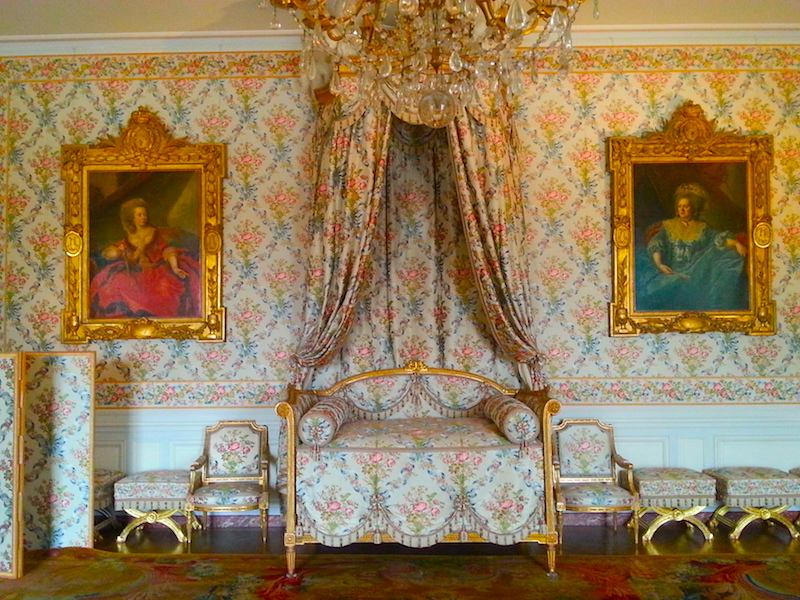
A Childhood at Versailles consists of the first 5 chapters of the memoirs of Mme de Boigne (1781-1866), née Adèle d’Osmond, who was a French salon hostess and writer. She was born in the Château de Versailles and lived at the court of Louis XVI and Marie-Antoinette until her family fled to England during the Revolution. Later in her long life, she married a rich soldier of fortune 30 years her senior, hosted a brilliant salon in Paris, and became an intimate of the last French queen, Marie-Amélie, consort of King Louis Philippe (r. 1830-1848). Childless herself, Mme de Boigne addressed her memoirs to her grandnephew. The memoirs were not published until 1907, under the title Récits d’une tante, or An Aunt’s Tales. They’ve never been published in English, as far as I know, so I’ve decided to translate the first 5 chapters, the ones that take place mainly at Versailles, and post them here on this blog for interested readers to enjoy for free.
The chapters are quite lengthy, so I’ve broken each one into several parts. In Part 2.6, the author describes Mme Adélaïde’s rather fraught relationship with her chief lady-in-waiting, the Duchesse de Narbonne, who seems to have been a bit of a bully. This Duchesse de Narbonne (1734-1821), born Françoise de Chalus, had been a mistress of Louis XV. What’s not explained in the original footnote at the bottom of the page is that it’s possible that Mme de Narbonne’s two sons, including the Comte Louis de Narbonne mentioned in this excerpt, were the King’s sons, and therefore Mme Adélaïde’s half-brothers. If true, it makes Mme de Narbonne’s hold over Mme Adélaïde more understandable.
A Childhood at Versailles, Chapter Two, Part Six (2.6)
Mme de Civrac hosted a salon for Mme Victoire that was suitably full of courtiers. Mme de Narbonne, however, added hardly anything more to the princess’s service than did the people who were invited to meals. Her arrogant personality did not permit any other relations. It was put about in libels of the time that the Comte Louis de Narbonne was Mme Adélaïde’s son. That is false and absurd, but it is true that the princess made enormous sacrifices for him. Mme de Narbonne, otherwise so imperious, submitted to every one of Comte Louis’ whims. When he committed an extravagance and was short of money, Mme de Narbonne would be in an insufferable mood, which she took out mainly on Mme Adélaïde, making her home life intolerable. After a few days, the poor princess would buy her peace and quiet back at at exorbitant price. This is how Comte Louis found himself supplied with enormous sums that were procured without the least effort on his own part, and which he spent with equal ease. In any case, he was the most agreeable and the least malicious of men; a scamp, to be sure, but only because he was always indulged.
Mme Adélaïde felt the weight of the yoke and bucked against it when she dared. One evening when my mother was accompanying her back to her rooms after leaving Mme de Narbonne, who had been more disagreeable than usual, she conceived the project of not going back the next day. Delighting in this idea, she gave chapter and verse on what Mme de Narbonne would say, how she herself would act, the firmness she would deploy, etc.
“You do not answer, Madame d’Osmond? You are wrong to think I would do it. I am weak, I am a Bourbon, I need to be lead, but I am never treacherous.”
“I do not even suspect Madame of such a thing, but I know that tomorrow she will be a little bit more than usually gracious to Mme de Narbonne to make up for this little infidelity in thought.”
“Alas, I fear you are right.”
And, sure enough, the next day a reckoning provoked by the princess led to a demand for money; it was given, and Mme de Narbonne was charming in the evening. The good princess, seeking to cast a veil over her weakness, said to my mother on retiring that Mme de Narbonne had apologized for her grumpiness the day before; she did not say how she had calmed her, but that was the secret behind this bit of theatre. Comte Louis was the first to have a good laugh about it, and this simplified his position, for, in those days any eccentricity, vice, or cowardice was sure to be indulged if it was avowed frankly and wittily.
The princess should have been accompanied from Mme de Narbonne’s rooms back to her own by the lady in waiting on duty. She frequently dispensed with their services, however, above all when it was cold because she always went on foot and the ladies usually circulated around the corridors and antechambers in sedan chairs. These chairs were very elegant. They were gilded and had coats of arms on the sides. Those of the duchesses were covered in red velvet, and they could have porters in their own livery. The other ladies had porters assigned to them, but they wore the King’s livery. In the language of the Court, these porters were called “the blue porteux,” for one was supposed to say “porteux” rather than “porteurs.”
For almost a whole year, Mme Adélaïde had made a habit of having my mother, and often my father, come into her rooms on leaving Mme de Narbonne’s. She had a taste for a more serious kind of conversation. However, Mme de Narbonne got wind of it. The princess was scolded, and she admitted very frankly that she no longer dared to continue the practice.
16. Comte Louis de Narbonne-Lara was born at Colorno in the Duchy of Parma in 1755. He was the son of the Duc de Narbonne-Lara, a gentleman in waiting to the Duke of Parma, Philippe de Bourbon (son of Philippe V d’Anjou), and the Duchesse de Narbonne-Lara, lady in waiting to the Duchess of Parma, Madame Élisabeth de France (daugher of Louis XV). After the princess’s death, Mme de Narbonne returned to France and became a lady in waiting to Mme Adélaïde. A constitutional royalist, Count Louis de Narbonne was Minister of War in 1791. He emigrated after 10 August. On the 18 Brumaire, he returned to France, rallied to Bonaparte, occupied various posts, and died in 1813.
Part 2.7 will feature a pair of anecdotes about prominent courtiers. Look for it sometime during the week of 11-17 March!

















Leave a Comment